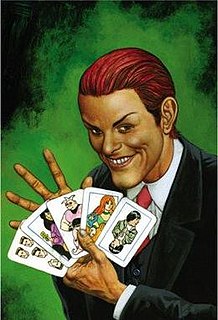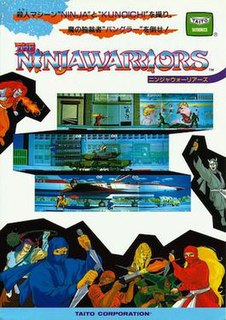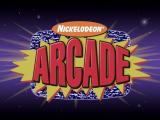
Final Fight is a side-scrolling beat-'em-up video game produced by Capcom. Originally released as an arcade game in 1989, it was the seventh title released for the CP System hardware. Set in the non-fictional United States of the fictional Metro City, the player controls one of three street fighters: former pro wrestler and city mayor Mike Haggar, his daughter's boyfriend Cody, as well as his daughter's best friend and Cody's worthy rival Guy, as they set out to clash with the Mad Gear Gang and rescue Haggar's young daughter Jessica, who the gang has kidnapped.
A full-motion video (FMV) is a video game narration technique that relies upon pre-recorded video files to display action in the game. While many games feature FMVs as a way to present information during cutscenes, games that are primarily presented through FMVs are referred to as full-motion video games or interactive movies.

Arcade is a fictional supervillain appearing in American comic books published by Marvel Comics. He first appeared in 1978's Marvel Team-Up #65, the creation of writer Chris Claremont and writer/artist John Byrne. The character is a combination of an evil genius and a hitman who carries out his assassinations via various elaborate traps, often referred to as Murderworld.
The golden age of arcade video games was the period of rapid growth, technological development and cultural influence of arcade video games, from sometime in the 1970s until about 1983. The exact time period is disputed, but key moments include the release of Space Invaders in 1978 and the vector graphics-based Asteroids in 1979, made possible by new computing technology that had greater power and lower costs. This led to the rise of video game arcades and the appearance of video games in media including songs, cartoons, and movies, most notably the 1982 film TRON. Other iconic games from this era include Pac-Man, Defender, Galaga, Donkey Kong, and Centipede.

In the Groove is a rhythm game published by RedOctane and developed by Roxor Games, and is the first game in the In the Groove series. The game was shown in an official beta-testing preview on July 9, 2004, and was officially released in arcades around August 30, 2004.

X-Men: Children of the Atom is an arcade game that was produced by Capcom and released on the CP System II arcade hardware in 1994 in Japan and in 1995 in North America and Europe.

Fantasy Zone is a 1986 arcade game by Sega, and the first game in the Fantasy Zone series. It was later ported to a wide variety of consoles, including the Master System. The player controls a sentient spaceship named Opa-Opa who fights an enemy invasion in the titular group of planets. The game contains a number of features atypical of the traditional scrolling shooter. The main character, Opa-Opa, is sometimes referred to as Sega's first mascot character.

American Laser Games was a company based in Albuquerque, New Mexico that created numerous light gun laserdisc video games featuring live action full motion video. The company was founded in the late 1980s by Robert Grebe, who had originally created a system to train police officers under the company name ICAT and later adapted the technology for arcade games. Its first hit game was Mad Dog McCree, a light gun shooter set in the American Old West. By mid-1995 they were recognized as the leading company in the medium of laserdisc-based arcade games. Almost all arcade games released by the company were light gun shooters and a number of them also had an Old West theme.
Arcade most often refers to:

Vanguard is a 1981 scrolling shooter developed by TOSE and published by SNK in arcades in Japan, then Germany, in 1981. It was licensed to Centuri for manufacture in North America in October 1981 and to Zaccaria in Italy the same year. Cinematronics converted the game to cocktail arcade cabinets in North America.

Time Crisis is a first-person on-rails light gun shooter series of arcade video games by Namco, which first premiered in 1995. The series is focused on the exploits of a fictional international intelligence agency who assigns its best agents to deal with a major threat by a hostile organisation, which has ranged from criminals, terrorists, to hostile military outfits, and mostly take place within fictional locations across the world. The arcade series differed from other light gun shooters of its time by incorporating unique mechanics, including the ability to duck into cover to dodge attacks and reload the player's weapon, and forcing players to complete battles in each level within an allotted amount of time.

Mad Dog McCree is the first live-action laserdisc video game released by American Laser Games. It originally appeared as an arcade game in 1990.

RoadBlasters is a combat racing video game released in arcades by Atari Games in 1987. In RoadBlasters, the player must navigate an armed sports car through 50 different rally races, getting to the finish line before running out of fuel.
Digital Leisure, Inc. is a Canadian publisher of software. The company formed in 1997 with the aim to acquire, remaster and publish numerous classic video-based arcade games such as the Don Bluth-animated titles Dragon's Lair, Dragon's Lair II: Time Warp and Space Ace. Over time, they have acquired the publishing rights to various full motion video games, which they have re-released on a variety of modern formats. In more recent years, they have produced original games as well.

The Ninja Warriors (ニンジャウォーリアーズ) is a side-scrolling beat 'em up developed and released by Taito in 1987. The original arcade game situated one display in between projected images of two other displays, creating the appearance of a triple-wide screen. Ports were released for the Amiga, Atari ST, ZX Spectrum, Commodore 64, Amstrad CPC, TurboGrafx-16, and Mega-CD.
A battle zone or battlezone is the location of a battle.

Armed Police Unit Gallop is a side-scrolling shoot 'em up arcade game produced by Irem in 1991. It is part of the popular R-Type video game series.

Nick Arcade is an American children's game show created by James Bethea and Karim Miteff and hosted by Phil Moore, with Andrea Lively announcing, that aired on Nickelodeon in 1992, airing originally during weekend afternoons, with reruns airing until September 28, 1997. It was taped at Nickelodeon Studios at Universal Studios Florida in Orlando. In Nick Arcade, two teams of contestants played two initial trivia rounds, with the winner advancing to the "Video Zone" to play against the virtual "Video Game Wizard" of the day.

ThunderJaws is a run and gun video game released in arcades by Atari Games in 1990. Home ports by Domark were published in 1991.













